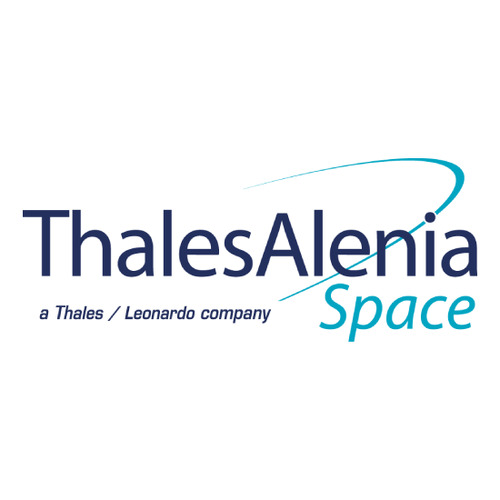The Euclid satellite is officially in the launch campaign phase at Cape Canaveral, the excitement is sky-high and there's very little time left till its departure! With the imminent launch, the team is tirelessly working to complete the final necessary actions before the satellite is launched into space.
Directly from Cape Canaveral, we talked to two referents of Euclid’s launch campaign team, Enrico Castaldini and Sergio Silvestri, to delve deeper into this intense preparation phase. They take us behind the scenes to discover the tasks and challenges of this incredibly exciting job.

© Thales Alenia Space
Enrico Castaldini is the AIT manager for the Euclid launch campaign in Cape Canaveral. He coordinates the AIT (Assembly, Integration and Testing) team to get the satellite ready for integration on the rocket and launch. He also works closely with ESA and several companies from Europe and the USA.
Sergio Silvestri is the Euclid product assurance manager. He coordinates various quality disciplines and establishes quality and technical requirements for Euclid based on ESA’s specifications.
Enrico, you and the team have a lot of work ahead in the next few weeks, with a series of intensive tests and ongoing operations. How are you preparing the satellite for launch? What main operations and checks will you be performing?
Enrico: When the spacecraft arrives at the launch site, the principal remaining task is to verify every single part of the spacecraft one last time, without skipping anything. Once everything is verified, the most thrilling and dangerous part of the spacecraft’s life on the ground starts. The spacecraft’s tank is pressurized with nitrogen at more than 250 times atmospheric pressure before filling it with hydrazine propellant. These perilous operations are performed by highly skilled individuals. After fueling, final adjustments are made and ground protections removed before encapsulation inside the rocket fairing. A few days later, the spacecraft is then transported to the launch pad, marking its final day on Earth. In the control room the team coordinates with ESA, ESOC and SpaceX to make sure the spacecraft’s subsystems are operational and clear it for launch.
What are the main challenges and key moments for you and the team during this launch campaign?
Sergio: A significant challenge of this phase is the very stringent cleanliness requirements imposed by the telescope, where the mirrors are housed with two other scientific instruments. This supremely delicate section has been permanently protected by specially designed covers tailored to the AIT sequence, save for brief periods for optical tests in a controlled ISO 5 environment. Thanks to our rigorous contamination control strategy, with relentless monitoring, meticulous inspection and cleaning, all the scientifically sensitive items are within the established contamination budget, which is paramount for the mission’s success.
Enrico: The launch campaign involves a lot of stress for the AIT team, with the culmination of over seven years’ work just two months away. While all the team members are highly knowledgeable specialists, they realize that the slightest error could jeopardize the launch date, so there’s a lot of pressure on them, with the potential for costly mistakes. That’s why it’s crucial to foster a collaborative and inclusive working environment and a strong team spirit to mitigate these risks and accomplish the most complex tasks safely.
Sergio, what were the main safety measures during the launch campaign?
Sergio: The most crucial safety measure revolves around the presence of hydrazine during the last two weeks of operations on the spacecraft. Hydrazine is corrosive, explosive and fatally toxic if inhaled. So, there are multiple hydrazine sensors at the base and a very loud alarm sounds if any molecule is detected in the air. Also, all areas exposed to hydrazine are evacuated before dangerous operations. Last but not least, everyone working on the spacecraft always keeps an oxygen mask within easy reach in case a hydrazine leak is detected and they can’t evacuate the area in time.
What do you like the most about the launch campaign atmosphere?
Sergio: The team is highly motivated and we have a great mix of young and seasoned experts. Every day, every moment is a challenge. All activities must be prepared and conducted with close attention, test procedures must be approved and verified on the test bench, and rigorous inspections carried out.
Enrico: What I enjoy most about the atmosphere is that the launch campaign is a time when team building reaches its peak. People live and work together for months, sharing experiences in foreign countries and forging lasting ties. The prevailing atmosphere is one of joy and unwavering enthusiasm, which creates the perfect working environment, with strong motivation and commitment to the project. No task is too difficult in such a positive atmosphere.

© ESA
With the launch now imminent, the atmosphere must be very emotional. Any last words for Euclid before its journey into space?
Enrico: When you’re in space, remember three things: behave yourself, produce good scientific data, and you will remain in our hearts! Fair wind Euclid!
Sergio: I’m incredibly pleased with the results, which have taken up 10 years of my professional life. We have overcome unexpected obstacles and now the finish line is in sight, which really means that Euclid is ready to probe the Universe’s dark mysteries. Euclid, the time has come for you to shine!
As we conclude these Euclid chronicles, which have taken us behind the scenes of this amazing satellite, get ready for the last interview before launch with Euclid mission program manager Paolo Musi, who will take us on an extraordinary journey revealing the final secrets still to be unveiled...
About the Euclid mission
Examining billions of galaxies up to 10 billion light-years away, and covering more than a third of the sky, Euclid is a European Space Agency (ESA) mission set to unlock a wealth of knowledge that will reshape our understanding of the cosmos. Scheduled for launch in July, this one-of-a-kind satellite will study the Universe’s dark matter and dark energy. Fair wind to our beloved satellite!


